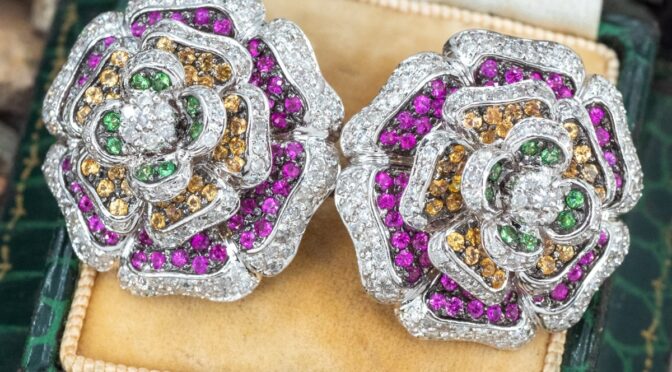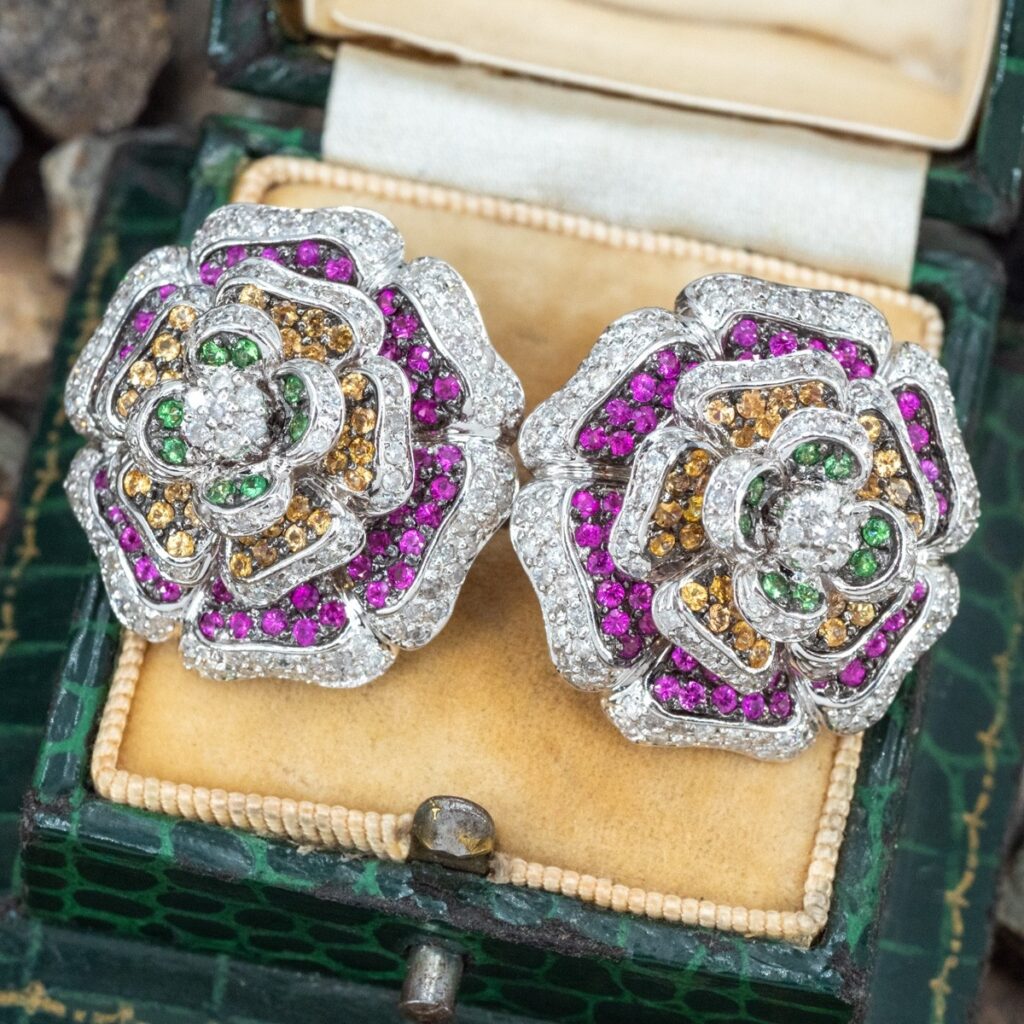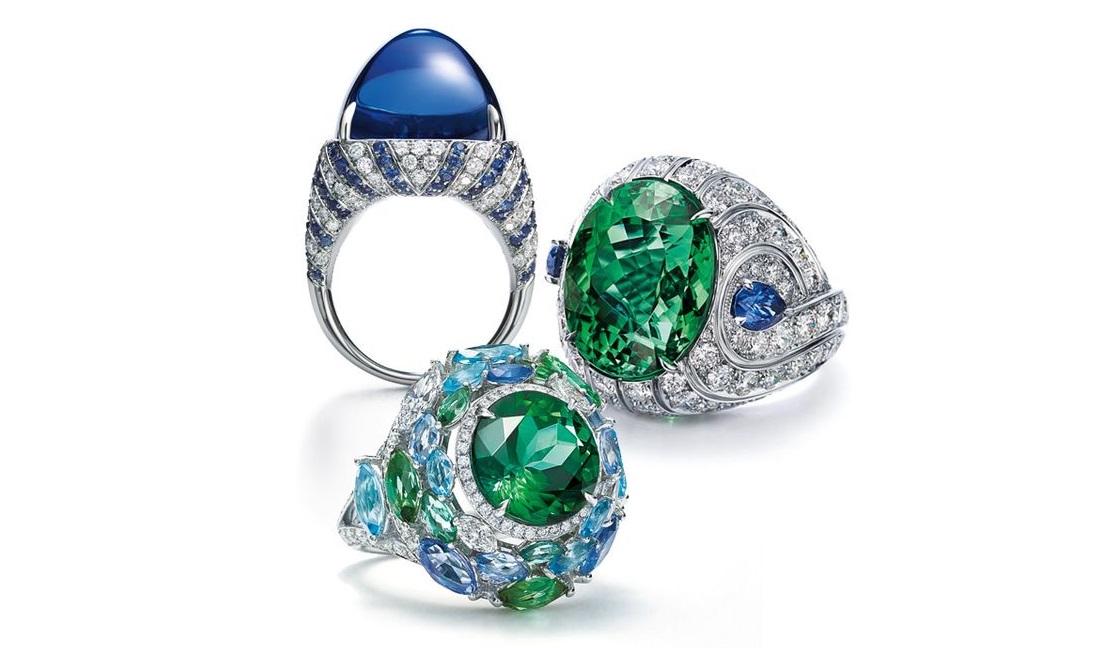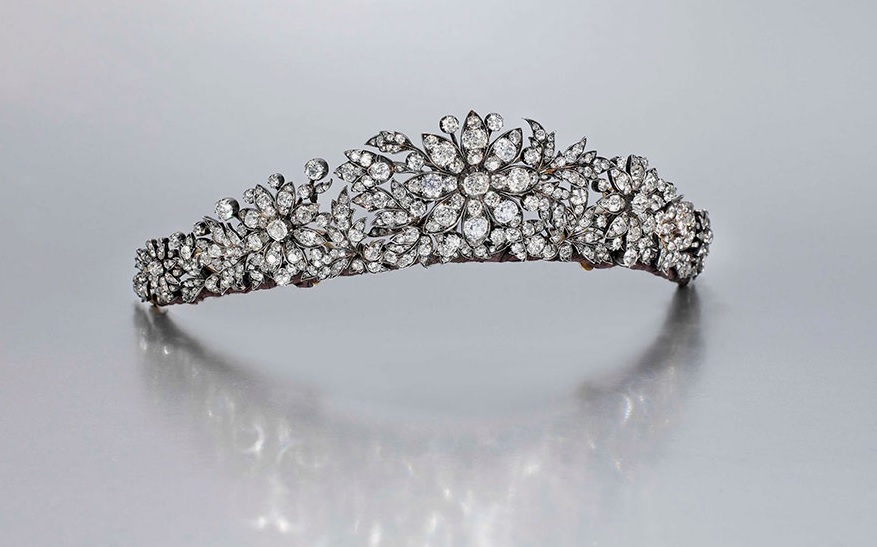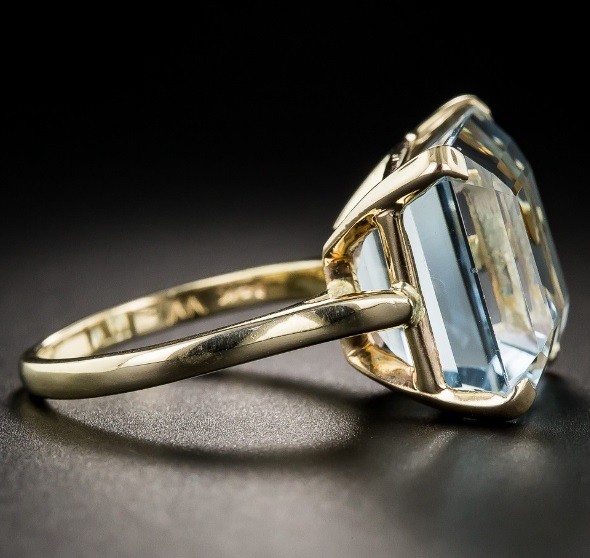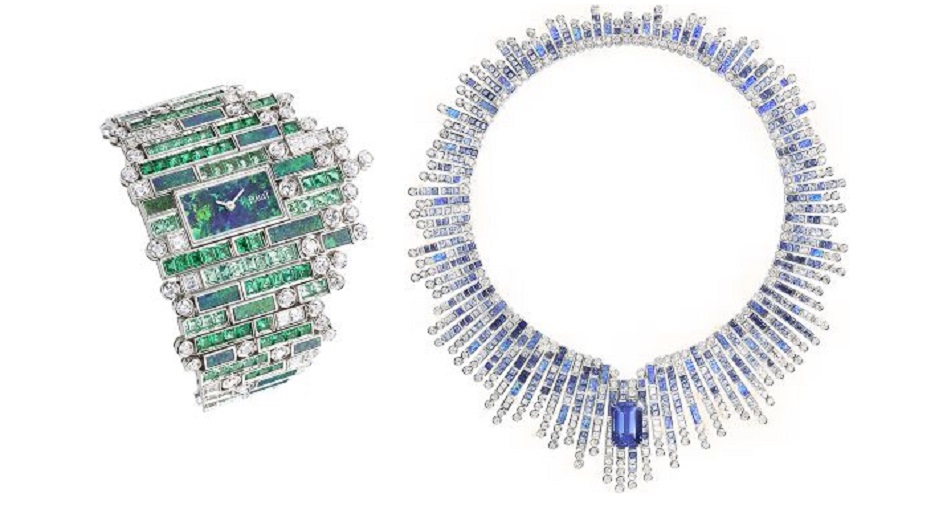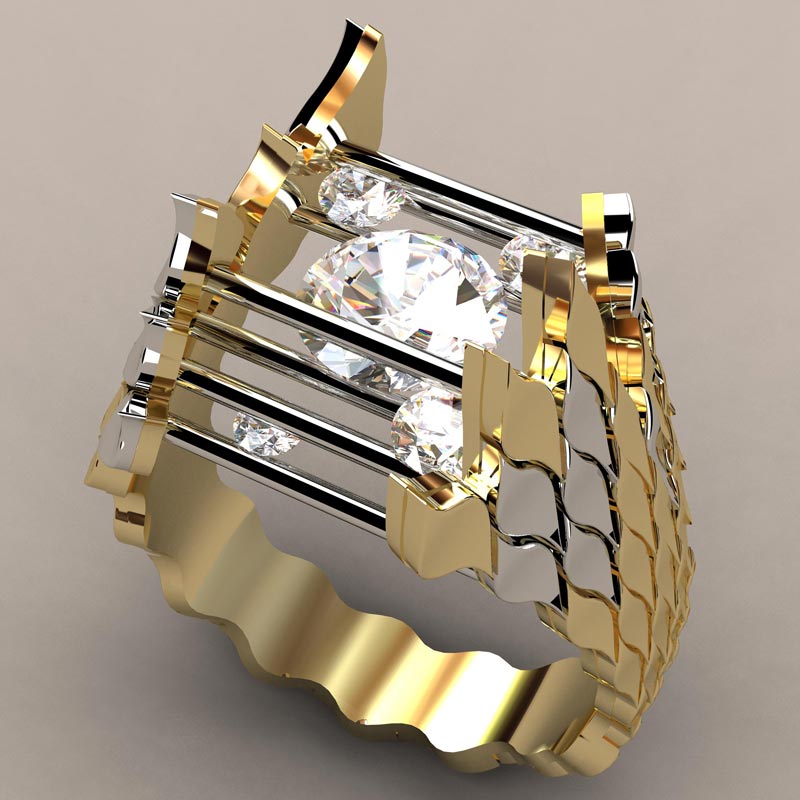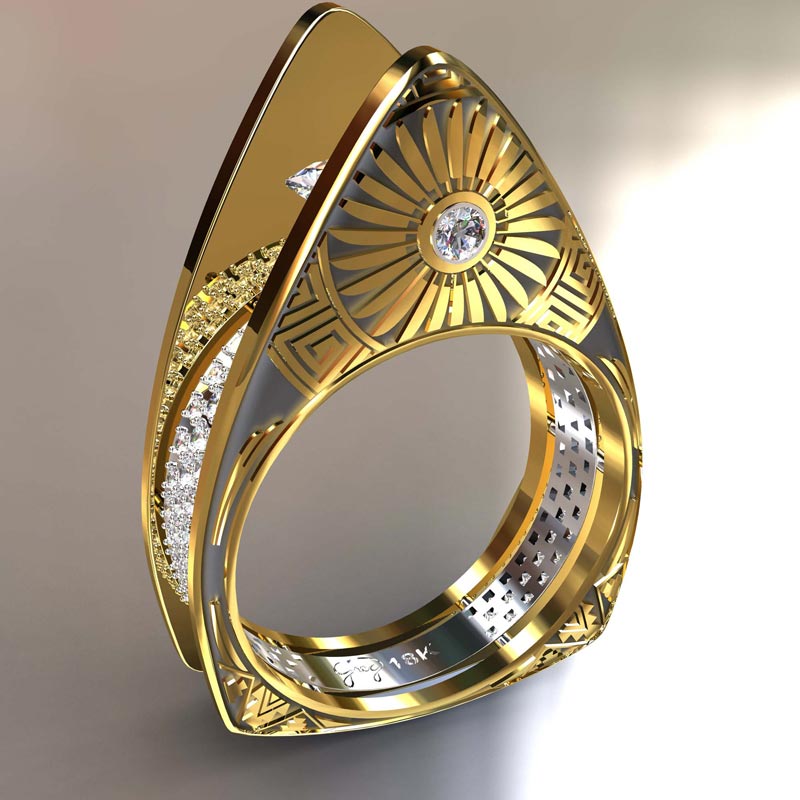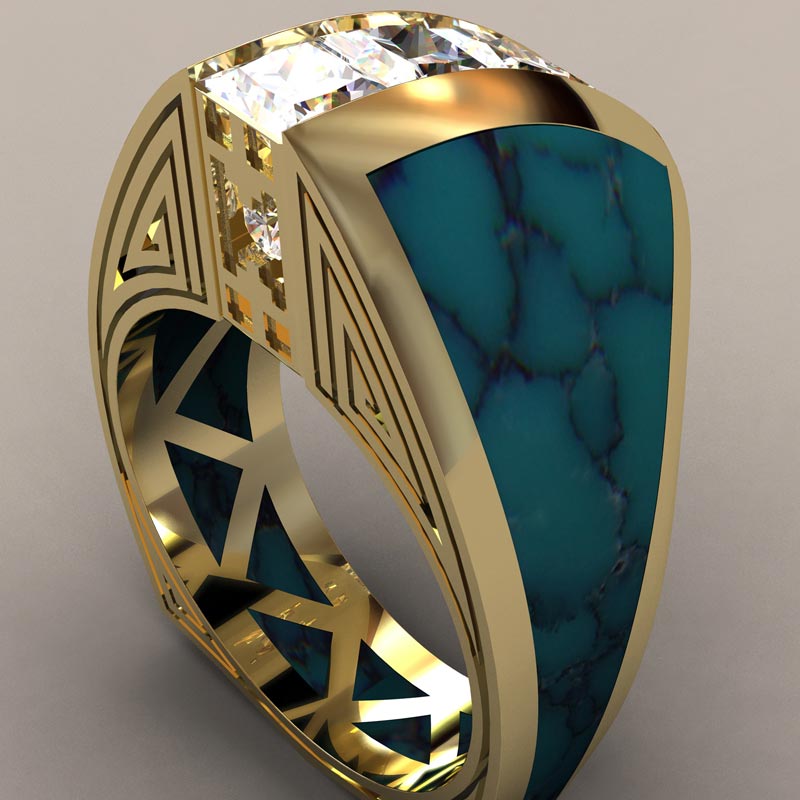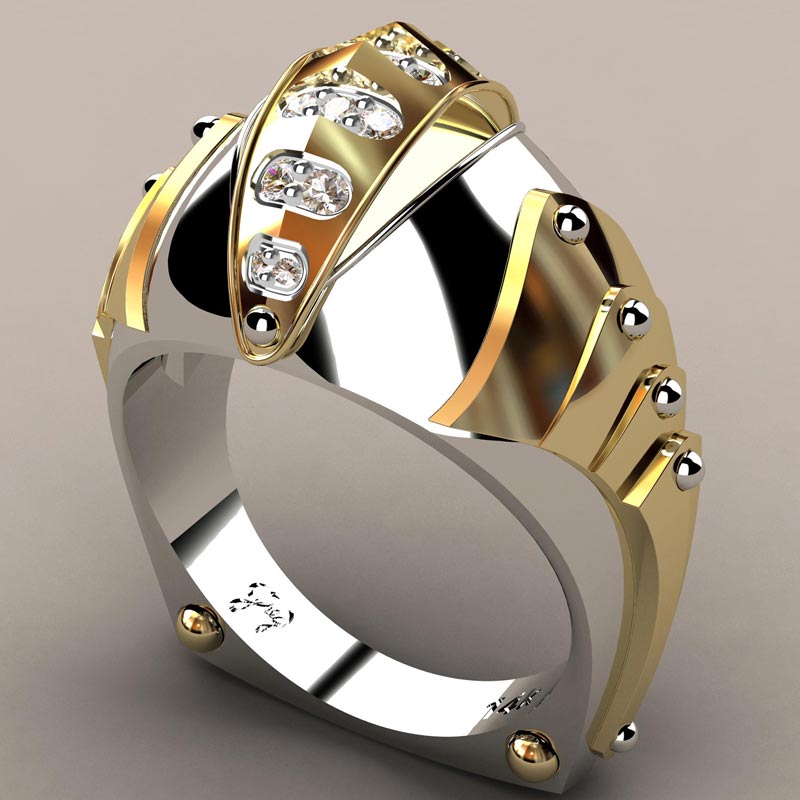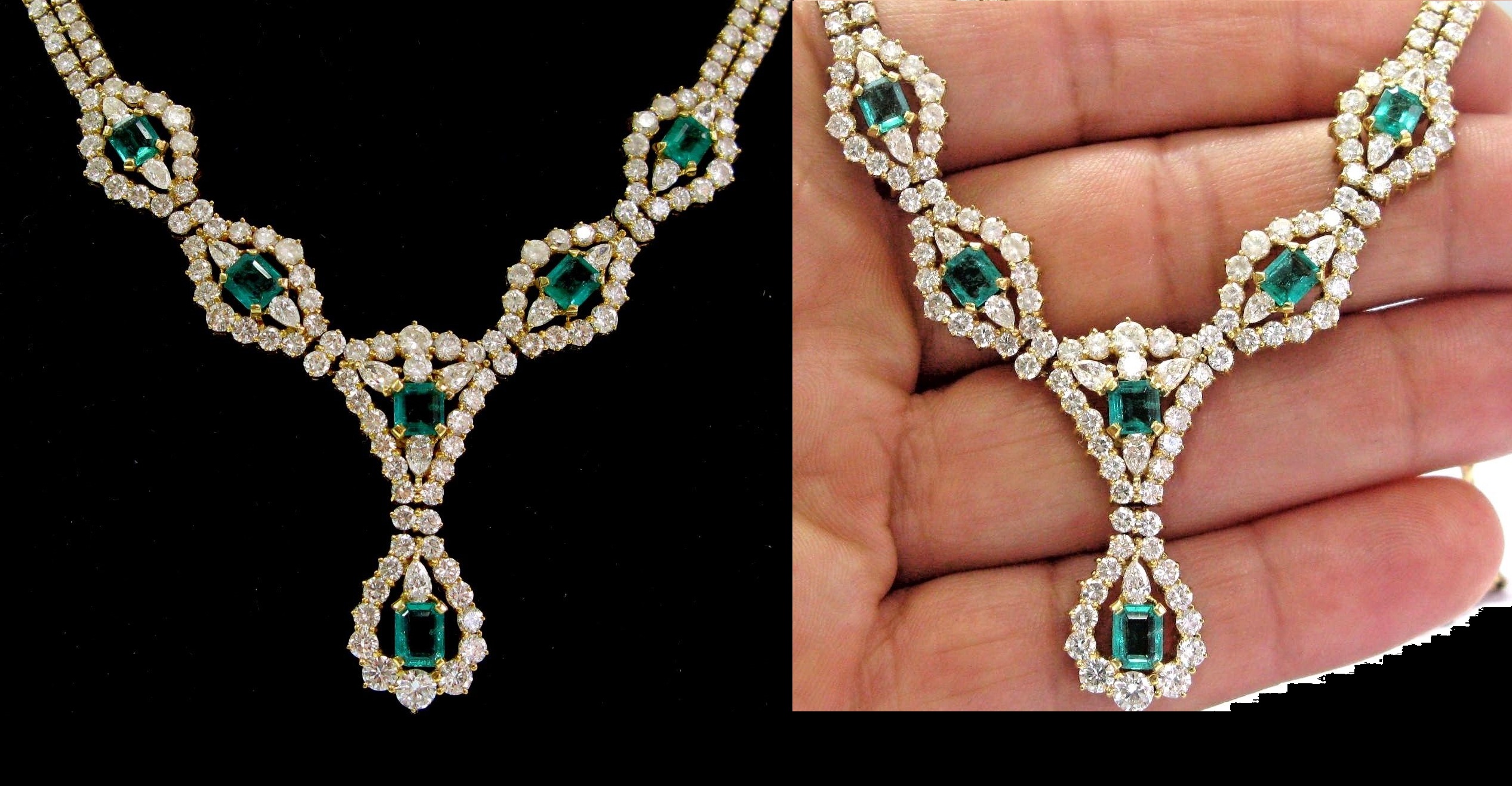These beautiful earrings feature a floral design, shared prong set with a total of one hundred thirty-one (131) round brilliant cut diamonds, fifty-five (55) round brilliant cut pink sapphires, thirty-five (35) round brilliant cut yellow sapphires and eight (8) round brilliant cut tsavorite garnets. The earrings measure 26.1mm wide by 13.6mm deep, finished with posts and omega style backs.
Tag Archives: Gemstone
Gorgeous Gemstone and Diamond Rings by Tiffany & Co.
Stephen Webster Jewels Verne Silver Turquoise, Blue Agate, Lapis, Mother of Pearl
Accentuate your ensembles in an unconventionally feminine fashion with this extraordinary jewelry piece that boasts an offbeat design topped off with dainty, enticing gems. The ring is presented by Stephen Webster within the fascinating “Jewels Verne” collection and it is expertly crafted from white rhodium-plated silver, decorated with agate, turquoise, lapis lazuli, mother-of-pearl, and quartz stones. Ring Top Dimensions: 40mm x 12mm
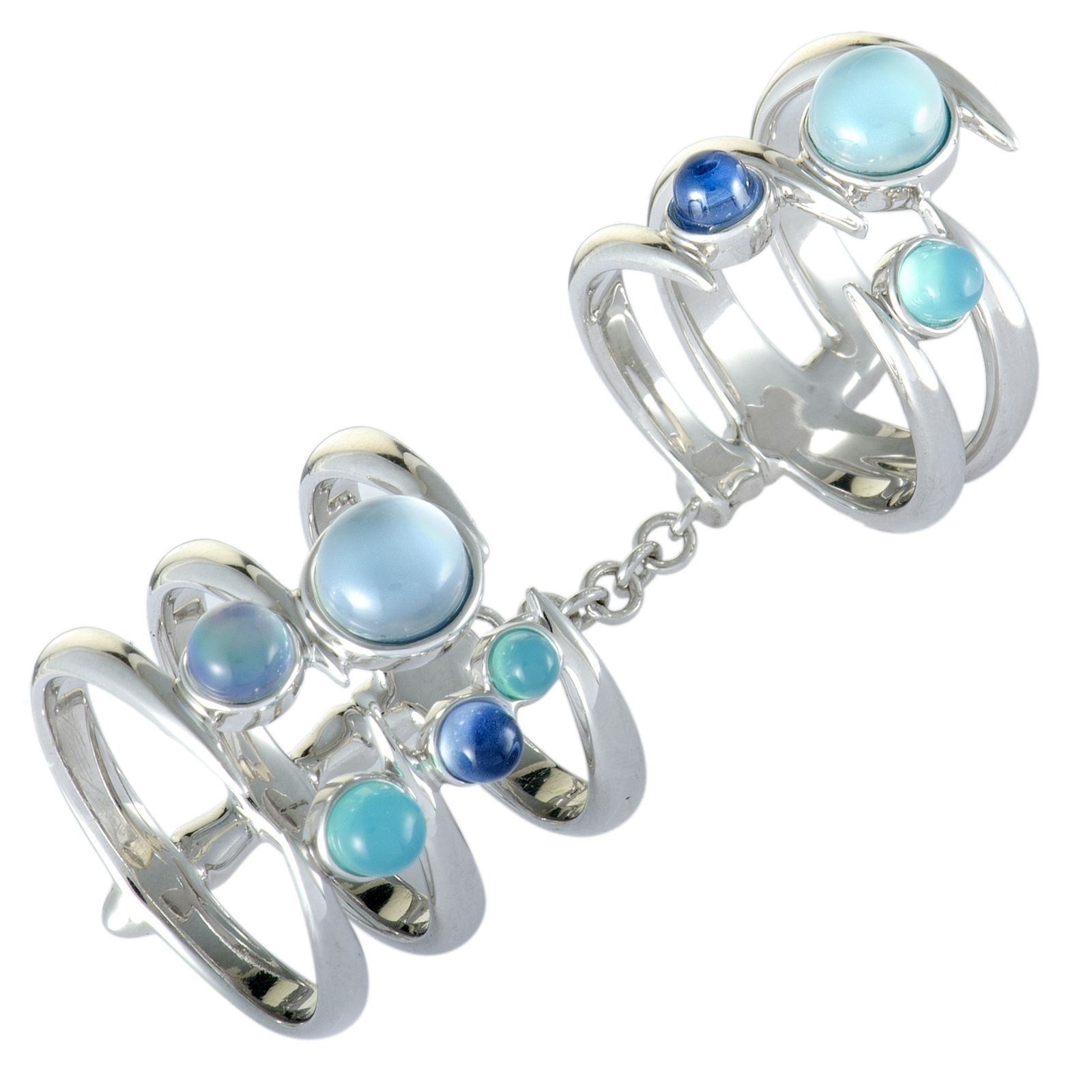
Diamond and Gemstone Tiaras of Exquisite Design
10 questions to ask about tiaras
An in-depth guide to these opulent ornaments for glittering occasions — from royal tiaras worn by queens and princesses to more versatile, wearable and affordable examples.
1. Do you have to be a queen, a princess or a member of the aristocracy to wear a tiara?
In ancient Greece garland-like hair ornaments were used to adorn the heads of sacred statues, given to athletes and warriors to honor victories, and worn by people of high rank at weddings and feasts. These early examples often took the form of gold bands, also known as fillets, or naturalistic foliate wreaths composed of ears of wheat, laurel leaves and flowers. The Romans continued the Greek tradition, but with the eventual demise of their world and the rise of Christianity, the wearing of classical wreaths and diadems declined and almost disappeared.
In the Medieval period crown-shaped jewels, or coronals, were worn by brides of all ranks, but it wasn’t until the 18th century that tiaras as we might know them today became more widely worn. This was probably due to advances in the cutting of gemstones — head ornaments became less the concern of goldsmiths and more the preserve of lapidaries for showing off their gem-setting skills. Relatively simple gold jewels made way for highly impactful and elaborate diamond and colored stone-set examples.
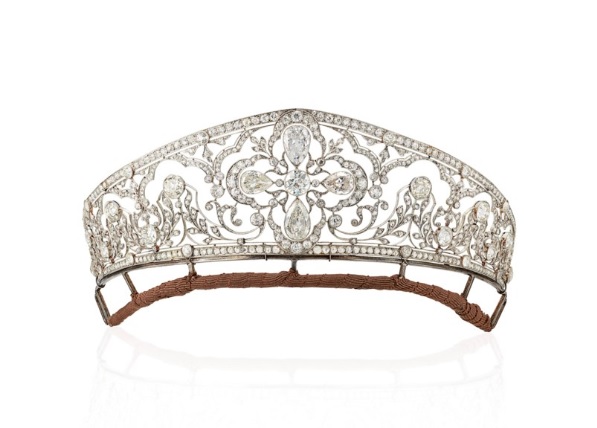
This resurgence of elaborate head ornamentation, displayed principally to denote status and affluence, was also associated with the emergence of a new class of wealthy individuals who were awarded titles and elevated into the aristocracy, as well as a renewed interest in Classical art.
Although many of these 18th-century tiaras have not survived, the tiara of Queen Charlotte, consort of King George III, was offered by Christie’s after her death in 1818. It was described as ‘a superb tiara composed of sprigs of flowers and brilliants, transparent, in setting of bold design, from which are suspended seven large emerald drops, in brilliant frames, a very large white round brilliant in the centre, the border of the whole of rose diamonds’.

Perhaps the peak of the tiara’s popularity, however, was from the 1870s to just before the First World War, when diamonds were plentiful following the discovery of new sources in South Africa, and hairstyles were suitably voluminous.
Throughout the 20th century the wearing of tiaras has fluctuated in line with changes in prosperity and fashion. In the past 20 years there has been a renewed appreciation for this type of jewel, fueled by various high-profile exhibitions and celebrity weddings. Wearing tiaras today is not a question of rank, but a matter of judging whether it is appropriate for the occasion.
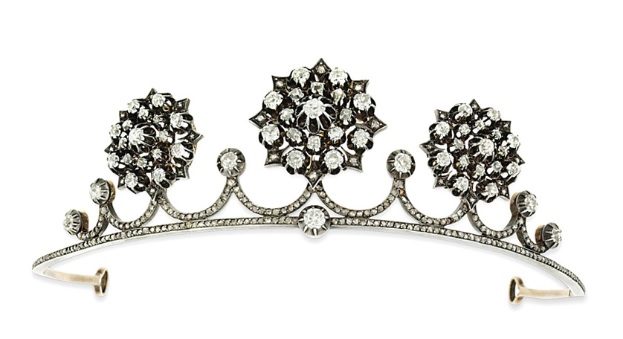
2. When should tiaras be worn?
Weddings, white-tie dinners and balls and occasions of state are all traditional events to which one might wear a tiara, however the boundaries are now increasingly blurred. Customarily, tiaras were only worn by married women and given to a bride on her wedding day, but rules are made to be broken — and they frequently are. Similarly, some say that tiaras should only be worn in private residences — and not in hotels, for example — but again, this seems outmoded in today’s more relaxed society.
3. What is the difference between a tiara, a circlet, a bandeau and a diadem?
Tiara: a more generic, overarching term for a number of different styles of head-dress, including diadems, circlets and bandeaux.
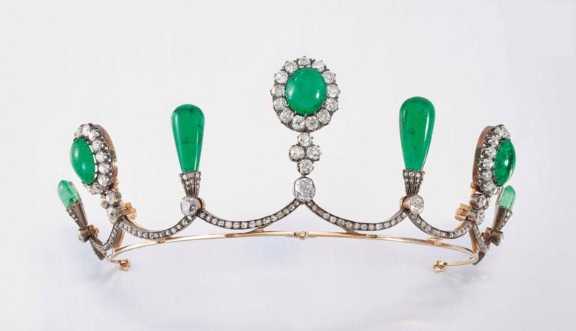
Diadem: there are differing opinions on the exact definition of this term. In ancient Greece the word diadem (from the term diadein, meaning to bind around) denoted several different types of head ornament. Later, the word diadem was used to describe a band worn over the head-dress of a king — it was the head-dress itself that was termed a tiara.
Circlet: a tiara that extends all the way around (or nearly all the way around) the circumference of the head.
Bandeau: a headband-style ornament of low profile, usually without a graduation in height from one side to the other, most often worn on the forehead, and prevalent during the early 20th century.
Kokoshnik: a style of embellished cloth-covered head ornament, often very broad and sitting high on the forehead, from the Russian national costume and folklore tradition. In the later 19th and earlier 20th centuries Fabergé and other jewellers were inspired to produce tiaras in the Russian taste. Kokoshnik tiaras are often designed as a fringe of tapering diamond-set bars or a continuous chevron-shaped panel.
Aigrette: a type of hair ornament worn centrally above the forehead that is designed to support a plume of feathers, or itself depicting a gem-set feather motif. The word is derived from the egret, the feathers of which were often used with these pieces.
Coronet: a miniature or simple crown, especially as worn by lesser royalty and peers or peeresses. Often made of gilded silver with velvet denoting rank: a viscountess’s coronet, for example, would have 16 ball or ‘pearl’ finials, whereas a countess’s coronet would have eight. Occasionally worn together with a tiara.
4. Besides diamonds, which gemstones are used for tiaras?
In the late 18th and early 19th century tiaras were commonly set with a wide variety of gemstones including coral, pearls, amethyst, turquoise, topaz and citrine — sometimes with diamonds and sometimes without. Cut steel and Berlin iron, although of low intrinsic value, were still of high status, and cameos and intaglios in all their forms were popular throughout the Napoleonic period.
In the later 19th century diamonds dominated but were often combined with sapphires, emeralds, rubies and pearls. By the 20th century the emphasis was more on design, resulting in the use of less precious but still beautiful stones such as aquamarines, onyx, citrine and rock crystal.
5. Who buys tiaras?
Primarily they are private individuals who are purchasing a tiara for the first time, usually for a wedding. In comparison to the overall cost of a wedding, a tiara or hair ornament does not need to be a wild extravagance and can be purchased for as little as £5,000 to £10,000. The other attraction is that these pieces can often be kept in the family and lent to other family members for their weddings.
Other buyers include jewelry connoisseurs who wish to crown their collections with a jewel epitomizing royal splendor, and professional jewelry dealers who wish to have tiaras available for loan to their clients.
Also buyers collecting tiaras of various styles to be exhibited in their private exhibition spaces. Similarly, museums and galleries occasionally purchase pieces to add to their existing collections. From time to time when an extraordinary signed tiara — most likely from the Art Deco, Art Nouveau or Belle Époque periods — comes to the market, the same jewelry house that created it all those years ago may buy it back to sell it on or keep it as part of its archive collection.

6. Are tiaras difficult to wear?
People sometimes think that there are limited occasions on which one can wear a tiara, but this is not always the case. Many tiaras, particularly 19th-century examples, are highly versatile and can be worn not only as a headpiece for a very formal occasion, but can also transform into a necklace for less formal events, such as the opera or a black-tie party.
Some examples can further dismantle to form brooches, hair pins, earrings and/or bracelets that can be worn in a much more relaxed environment. This means that if you are attending a social occasion that does not quite call for the full regalia, you can wear an arrangement of diamond-set brooches on your lapel or waist, or perhaps a couple of diamond pins in your hair.

Other common misconceptions are that tiaras are heavy, old-fashioned or fussy in design. Of course, some antique examples are highly elaborate and were made during a period when women wore high pads of false hair. Such examples (known colloquially as ‘fenders’) can be disproportionately high, and are not as easy to wear with modern hairstyles. There are, however, many tiaras from the early 20th century that have a fresh and modern aesthetic — for example, the simple, diamond-set Belle Époque diadem, below, and Art Deco tiara by Cartier pictured above could easily be worn as an accompaniment to a modern gown or dress.
7. Tiaras for sale — is it possible to find affordable examples at auction?
Absolutely. Over the years Christie’s have offered many beautiful tiaras in our London auctions, with estimates starting from approximately £3,000 for smaller antique examples.
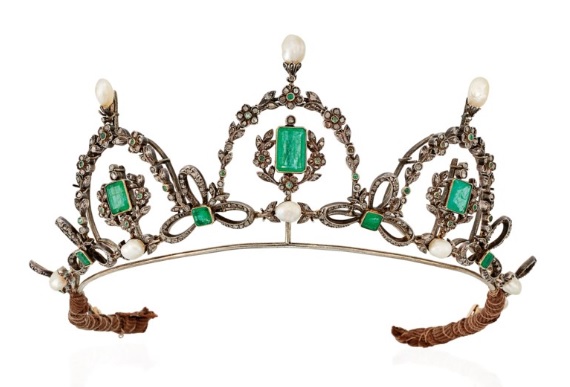
Unsurprisingly, as the gemstone content increases so does the price, but it is still possible to find more significant examples for under £15,000.
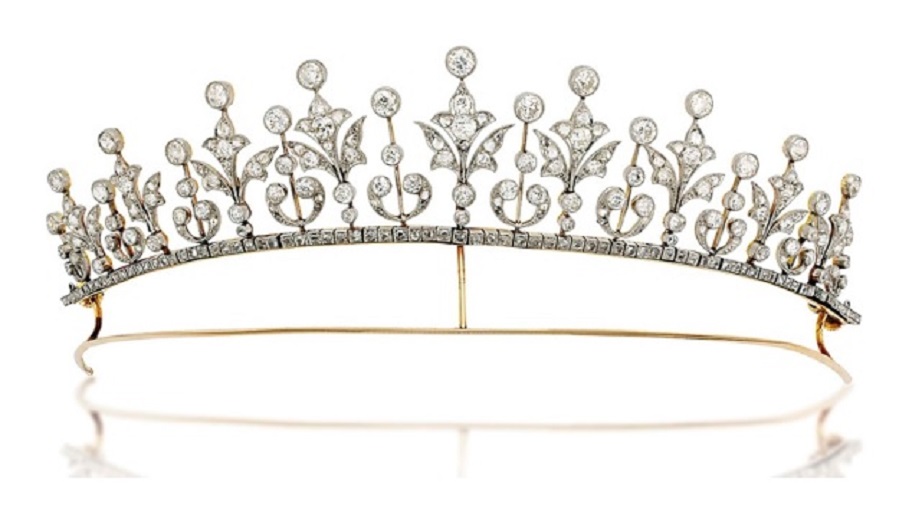
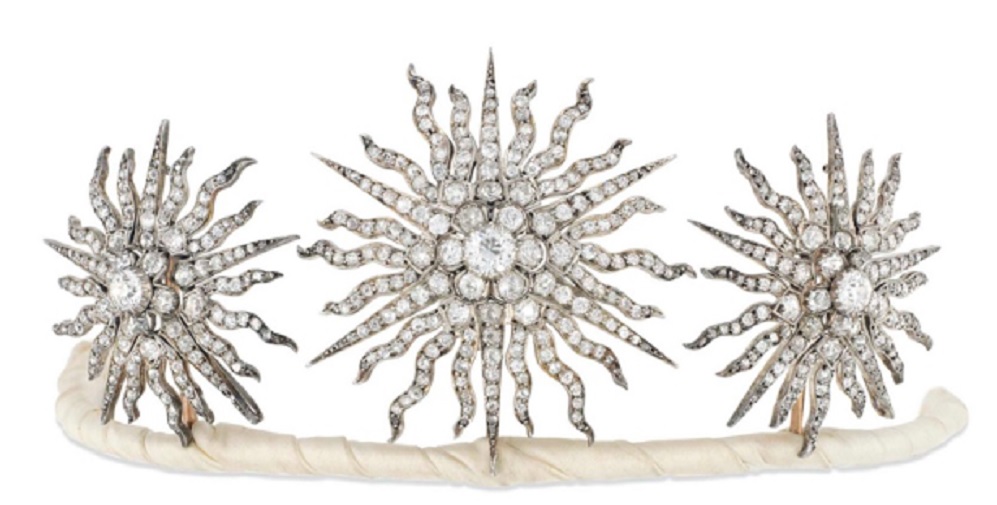
8. Royal tiaras — what are some of spectacular tiaras sold at Christie’s?
In 2006, Christie’s was entrusted with selling The Collection of Princess Margaret. Among the beautiful pieces in her collection was the Poltimore Tiara, pictured near the top of this story — an elaborate late 19th-century jewel of impressive scale. It was bought in 1959 just prior to the announcement of her engagement to Mr Antony Armstrong-Jones. The princess wore the transformable tiara as a necklace on many state and official occasions but, most famously, on her wedding day at Westminster Abbey in 1960.
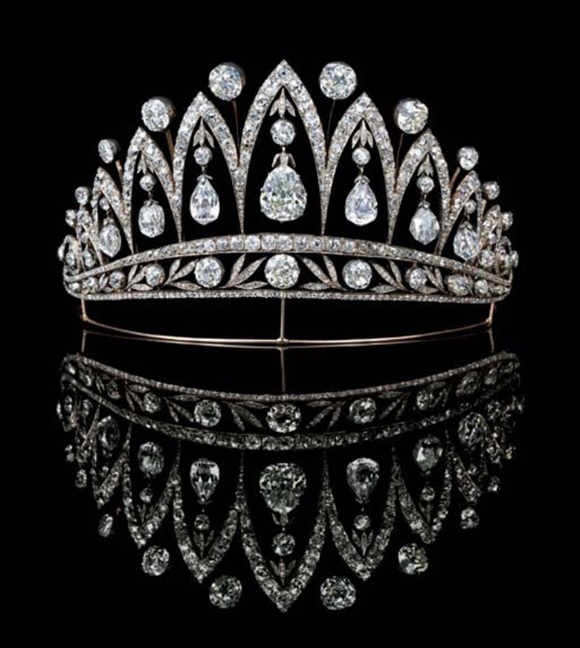
In 2007 Christie’s sold a magnificent tiara set with a graduated series of large diamond briolettes by Fabergé. Important antique jewels by the house of Fabergé are very rare, although tiaras are rarer still since relatively few were produced. Contributing greatly to the importance of the piece is its well-cataloged provenance, which includes Queen Maria José and the King of Belgium. Furthermore, the briolette-cut diamonds were said to have been a gift from Tsar Alexander I of Russia to the Empress Josephine.
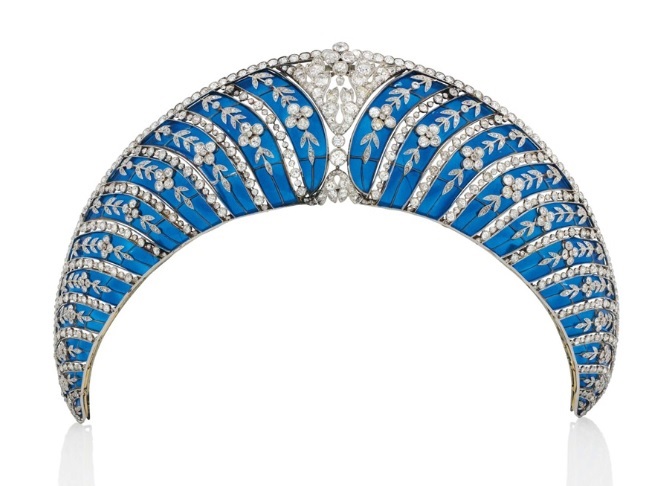
More recently, in 2015, Christie’s offered in our Geneva saleroom a beautiful Belle Époque blue enamel and diamond tiara by Chaumet (above), which was bought by the Duke of Westminster for his wife on the event of the coronation of George V and Queen Mary in 1911. The plique-à-jour enamelling, giving the appearance of a glowing stained-glass window when held up to the light, is very delicate but has remained in immaculate condition despite its age, making the piece a very rare survival.
9. What other jewels can be worn in the hair?
If you do not own a tiara but have in your jewel box a pretty pair of double-clip brooches, these can be used successfully to adorn the hair, perhaps pinned in to either side of a chignon, or used as clips to keep loose hair back. Pins can be used in the same manner, to best effect with three or four slid into an up-do.
If you have a bracelet or necklace that you would like to wear as a tiara, a good jeweler may be able to produce a discreet frame so that it can be worn in the hair. This could work well with a diamond rivière necklace, for example.
It is worth mentioning that great care must be taken when wearing jewels in this way that are not designed as hair accessories — you can always ask your hairdresser how to secure them firmly in place to avoid them coming loose or slipping out.
Elizabeth Taylor knew how to make an entrance, and would often wear brooches from her extensive jewelry collection in her bouffant-style coiffure to draw attention and to add height. Diana, Princess of Wales, of course, also famously employed an Art Deco bracelet as a bandeau worn on her forehead.
10. If you could pick a tiara, which one would it be?
The ideal head ornament would be a diamond-set tiara ideally from the Art Deco period or early 20th century — something light in appearance that does not sit too high on the head, with an elegant and understated design. If I could find an example that transforms into a pair of bracelets or a necklace, then that would be very chic.
Watermelon Tourmaline Gemstones
With its juicy burst of color, the aptly named watermelon tourmaline perfectly mimics the rind and flesh of our favorite summer fruit. Here we take a closer look at the origins of the watermelon tourmaline and talk to the designers who have a particular preference for working with this one-of-a-kind gem.
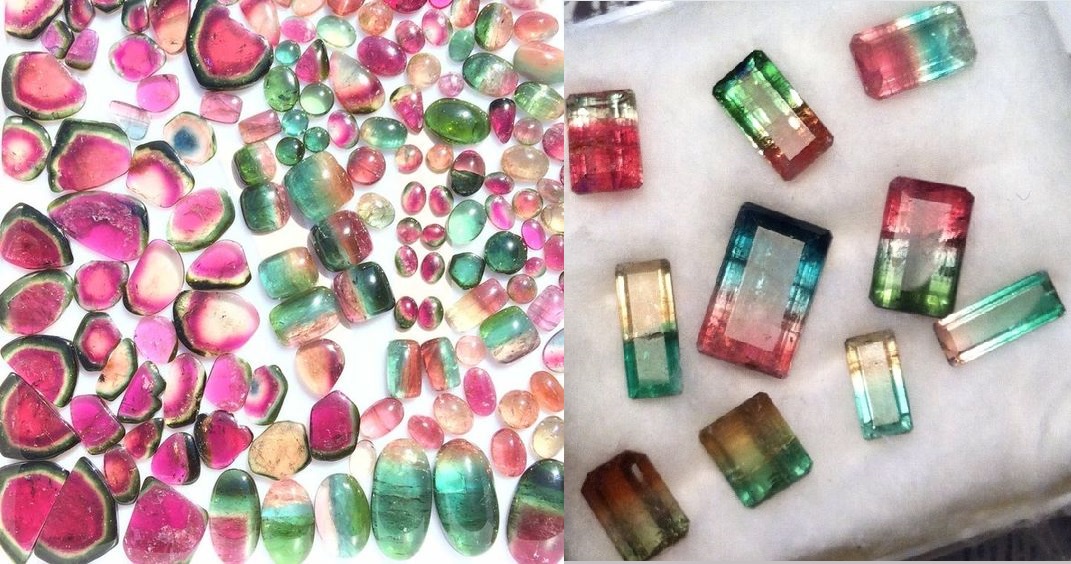
Most tourmaline deposits are found in veins that run through rocks, which were created by molten magma from volcanoes. As the magma cooled, large cracks formed, which were filled with a solution of water and minerals such as iron, lithium or manganese that, over time, turned into crystals of tourmaline and other stones. It is these trace elements that give tourmalines their vivid colors, ranging from red, green and blue to yellow and orange.
Динев турмалин
Watermelon tourmaline
#watermelon #bicolor #tourmaline #jewel #jewelry #jewelery #gem #gemstonePosted by Lapis Magica on Monday, April 3, 2017
Watermelon tourmaline is an interesting multi-colored elbaite variety. Gems are usually fashioned in thin polished slices to display the crystal’s concentric color rings. If you use your imagination, the green represents the skin of the watermelon, white makes up the rind, and pink is the sweet fruit. Incredibly, the colors of watermelon tourmaline are 100% natural, a rare occurrence in nature that makes the gem highly collectible.


Gorgeous Vintage Aquamarine Solitaire Ring
The name “aquamarine” is derived from two Latin words: aqua, meaning “water,” and marina, meaning “of the sea.”
It has been said that the mineral beryl gives the wearer protection against foes in battle or litigation. It makes the wearer unconquerable and amiable, and also quickens the intellect.
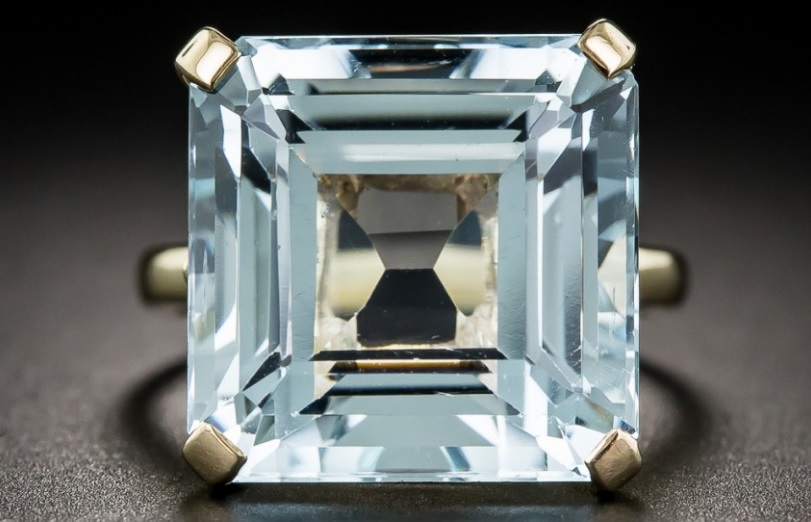
A cool refreshing blue square-cut aquamarine, weighing approximately 14 carats, is presented with straightforward mid-century minimalism in this lovely solitaire cocktail ring, crafted in 14K yellow gold and currently ring size 5 1/2. The aqua measures just over 1/2 inch.
ITEM DETAILS
Materials: 14 Karat Yellow Gold
Current Ring Size:
Most rings can be resized up or down one size unless noted and sometimes more. 5 1/2
Length: 5/8 Inch
Height: 7/16 Inch
CENTER AQUAMARINE DETAILS
Cut/Shape: Square Emerald Cut
Carat Weight: 14.00 carat
Measurements: 14.25 x 14.32 x 9.93 mm
Gorgeous Vintage Aquamarine Solitaire Ring
NIGHTFALL CELEBRATION by Piaget
The heat of the afternoon sun gradually subsides. Gardens take on vibrant colours and exude fragrant scents. Women shine in flowing dresses painted with flowers.
Lavish rose bougainvillea encircles the dial, meticulously crafted of micro-mosaic, taking on an intense and luminous fuchsia rose hue (G0A42194). The sky is clothed in orange, rose and gold and the sun glows in all its majesty one last time before dipping beneath the horizon, like this cuff-watch adorned with a purplish rose spinel. It radiates colourful beams of pink sapphires and red spinels (G36M5600).
This flaming sky spells the start of a festive evening, where everything will be lived with the greatest intensity. Luminously resistant to nightfall, a cushion-shape yellow diamond glows with spectacular radiance in the company of red spinels, yellow and white diamonds.
Gorgeous Natural Uncut Emerald Gemstone
Gorgeous Natural Uncut Emerald Gemstone
Emerald is the green to greenish blue variety of beryl, a mineral species that also includes aquamarine as well as beryls in other colors.
Gorgeous Natural Uncut Emerald Gemstone
Emerald is the green to greenish blue variety of beryl, a mineral species that also includes aquamarine as well as beryls in other colors.
Gem experts differ on the degree of green that makes one stone an emerald and another stone a less-expensive green beryl. Some people in the trade tend to give the name emerald to any green beryl colored by chromium. But to most gemologists, gemological laboratories, and colored stone dealers, it is more correct to call a stone green beryl when its color is “too light” for it to be classified as emerald. Even among that group, however, there’s a difference of opinion about what’s considered “too light.”
GIA uses lab-graded comparison stones to determine if the green color is dark enough and saturated enough to be called emerald.
Gorgeous and Innovative Designer Ring Creations
Gorgeous and Innovative Designer Ring Creations by Greg Neeley
These are some of the most innovative designer ring creations in today’s market, and these designs will endure the ages. These designs are unique, and inspirational passion went into creating each one these gorgeous designs. The designs have articulate and intricate movement in the settings which makes you feel as one with these masterpieces. The gemstones that are used in these designs are sourced for their beauty and perfection. Some of the most beautiful diamonds and gemstones are placed with intricate passion into each piece by master jewel setters. Greg Neeley has been designing and making jewelry and since 1972. His unique designs and attention to detail are unsurpassed in the jewelry industry.
CLICK HERE TO PURCHASE GEMSTONE RINGS
Caged Fire, finalist in the 2013 Saul Bell Design Awards This original design by Greg Neeley is made from solid18k rose and 18k white gold. It contains five diamonds. The center stone is 2.23 carats with four diamonds weighing 1.01 carats total set around the center diamond. Caged Fire is for sale and on display at Elinoff and Co. Gallery.
This 14k yellow and 14k white gold ladies ring contains one 8×10 mm oval red zircon weighing 4. 85 carats and 27 1.8mm princess cut diamonds weighing 1.06 carats total. The ring is lost wax cast and soldered together. The shank in 18k white gold will be cast with a break in the bottom center, the princess cut diamonds will be channel set and the yellow gold plates soldered into place. The break in the bottom center will allow the channels for the zircon to be sprung open enough to tension set the zircon then the bottom of the shank will be welded and the ring rounded locking the zircon in place.
This ring has a ‘bracket set’ marquis diamond floating over a white gold band set with pave’ diamonds. There is a diamond in the center of each side of the ring. The total weight of 48 small diamonds is a little over 1/2 carat, and the center stone is a one carat marquis. This is a very safe design that looks very dangerous. The marquis diamond points are bare but it would be very difficult to touch the points with anything but a very small probe.
Indian Princess is an 18k yellow gold ladies ring containing 4 princess cut diamonds 1 carat each. It is made with the highest quality spider web turquoise that is inlaid all the way through the ring so you can see it from the inside. The vertical side of the ring is decorated in a Hopi Indian design and contains one .10 carat fine diamond. This ring is not for everyone and is one of the most difficult to craft that Greg Neeley has ever designed.
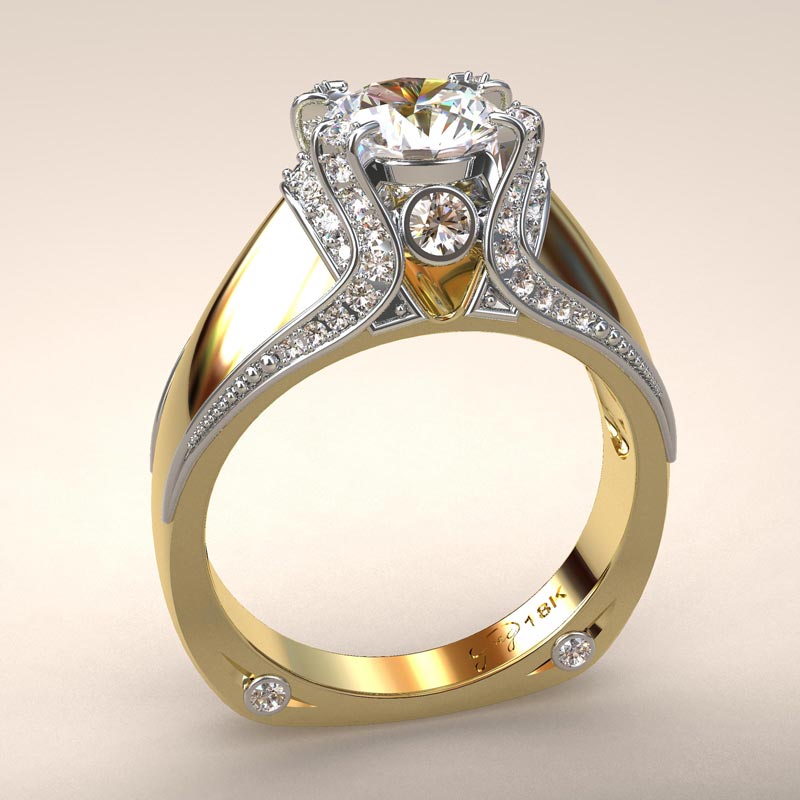
The center diamond is 1.00 carat GIA certified round brilliant. It is very well cut graded at color G clarity VS 1. The accent diamonds weight a total of .25 carats and are of top quality. The ring is made of solid 18 karat yellow and white gold. It can also be ordered in all white gold as well. This is a very elegant ring that brings a little Italian flare to one of Greg Neeley‘s ring forms.
This solid 18k Yellow and White Gold Men’s ring contains 17 high quality round diamonds weighing 1/5th carat total. The ring weighs over 2/3 ounce of solid gold. It is a very heavy and regal design. This is the latest in Greg Neeley‘s Medieval Knight Collection.
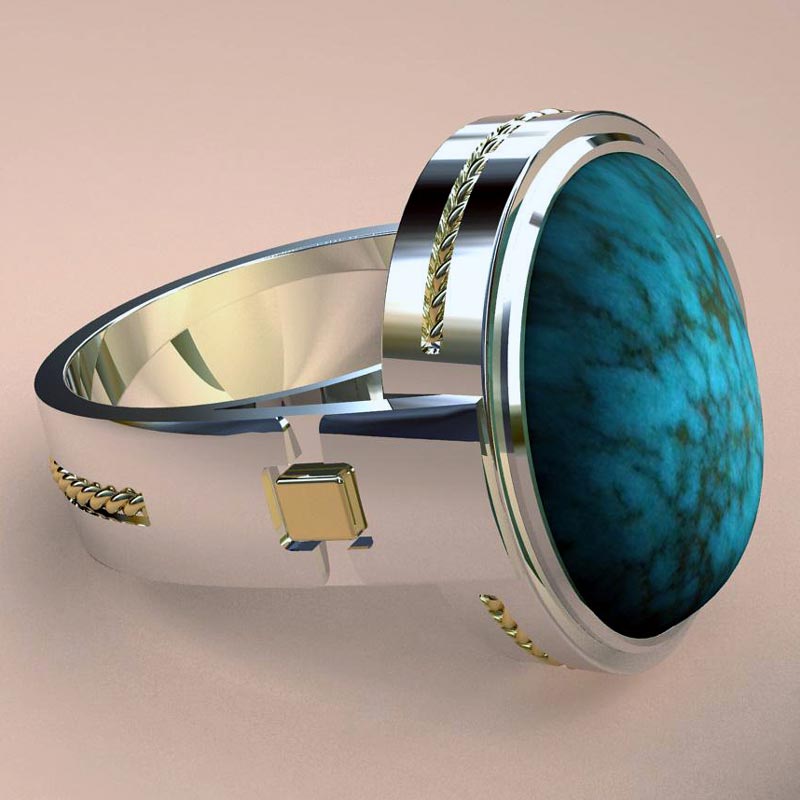
This ring is sterling silver and 18 Karat yellow gold with a beautiful spider web Carico lake stone. The Carico lake turquoise is 16 mm by 13 mm about 3/4inch by 1/2 inch. The turquoise weighs13 carats and is re-enforced with backing. The stone is completely natural with no treatment. One of the amazing aspects of this stone is the matrix or brown lines. Many times these lines are of a softer material and tend to degrade and pit during polishing. This stones matrix is crystalline like the rest of the turquoise stone, very rare in natural turquoise. Greg Neeley collected this stone in the late 1970’s when he was a turquoise stone buyer for an Indian jewelry manufacturer here in Colorado. The ring can be made to any size from 7 to 13 for the same price.
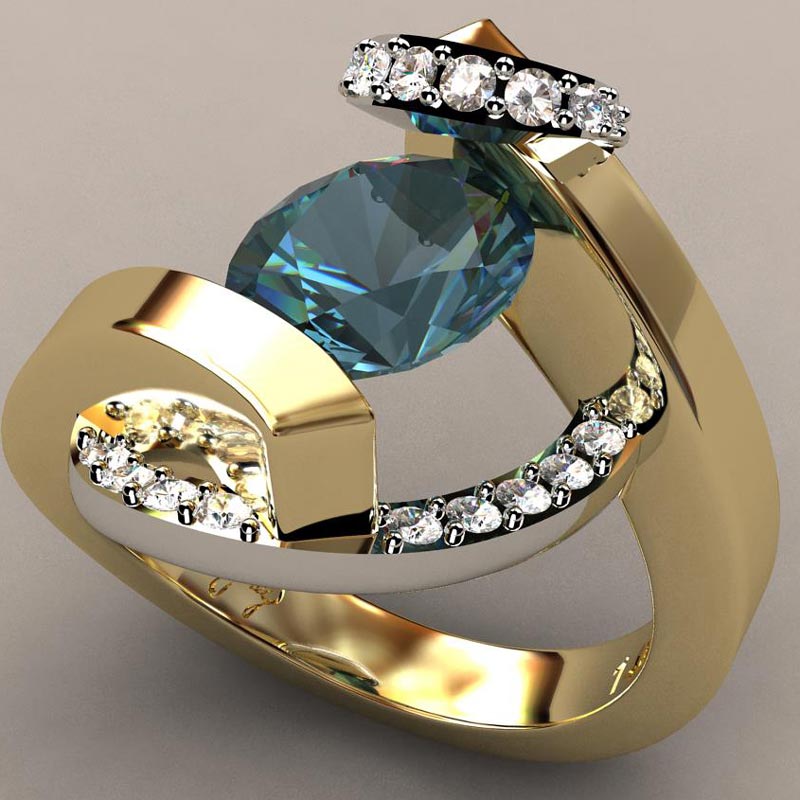
This ring is made of 14k yellow and white gold and holds a 2.3 carat natural aquamarine oval center stone suspension set in a 14k yellow gold wrap around ring with a 14k white gold swirl encompassing the entire ring top. There are 23 diamonds set in the swirl weighing a total of 1/4 carat. This is a simple but elegant and comfortable ring.
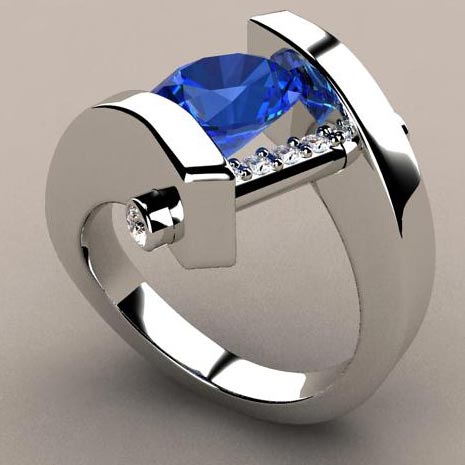
This ring is made of 14k white gold 3 carat natural aquamarine oval center stone suspension set in a 14k white gold wrap around ring with a 14k white gold bar running through the entire ring top. There are 5 diamonds set in the bar weighing a total of 1/10 carat. This is a simple but elegant and comfortable ring.

The ring is made of solid 18k gold. the black metal is 18k white gold with a layer of black rhodium over it. Rhodium is a form of platinum. It is very durable and just about the same price as platinum. There are 52 round melee diamonds in the ring and one 3/4 carat marquis. The total diamond weight is 1.61 carats. The Marquis is FLOATING in side brackets with the points bare. This gives the design a very dangerous look but the stone is protected by the sides of the ring and it would be very difficult to damage the stone. The brackets holding the stone are riveted on and all these rivets are real rivets.
Every gemstone has a story, a story of how it was formed, how it was found, how rare it is, how durable, how it is cut, how we found it, and most of all how beautiful it is. Greg Neeley respectS this story just as he respect your story of who you are, what you like, and where you are going. Greg Neeley strives to design and make jewelry that employs his forty years in art, design, and jewelry making to honor your story and the gems story
What Kind of a Design and Gemstone are you looking for?
A Spectacular Colombian Emerald and Diamond 18K Gold Necklace
18K Gem Colombian Green Emerald & Diamond Yellow Gold Necklace 16″ 11.20Ct
A Fine Gem Colombian Emerald Diamond Necklace. Made from Solid 18K Yellow Gold and weighs 37.3 grams. It holds 2.66Ct of Natural Colombian Green Emerald that are AAA Color VS Clarity. Necklace also holds 7.35Ct of Natural Round Brilliant Diamonds, 1.19Ct of Natural Pear Shape Diamonds, which are all F Color VS1 Clarity. Necklace is 16 inches long and has a 1.5 inch drop in the center. Hallmarked K18.
This Gorgeous Necklace is available at Diamond Doctor Jewelry

